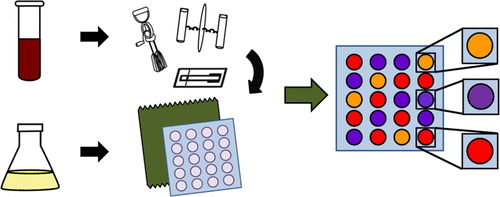当前位置:
X-MOL 学术
›
ACS Synth. Biol.
›
论文详情
Our official English website, www.x-mol.net, welcomes your
feedback! (Note: you will need to create a separate account there.)
Development of a Pigment-Based Whole-Cell Zinc Biosensor for Human Serum
ACS Synthetic Biology ( IF 3.7 ) Pub Date : 2017-12-22 00:00:00 , DOI: 10.1021/acssynbio.7b00292 Daniel M. Watstein 1 , Mark P. Styczynski 1
ACS Synthetic Biology ( IF 3.7 ) Pub Date : 2017-12-22 00:00:00 , DOI: 10.1021/acssynbio.7b00292 Daniel M. Watstein 1 , Mark P. Styczynski 1
Affiliation

|
Deficiencies in vitamins and minerals (micronutrients) are a critical global health concern, in part due to logistical difficulties in assessing population micronutrient status. Whole-cell biosensors offer a unique opportunity to address this issue, with the potential to move sample analysis from centralized, resource-intensive clinics to minimal-resource, on-site measurement. Here, we present a proof-of-concept whole-cell biosensor in Escherichia coli for detecting zinc, a micronutrient for which deficiencies are a significant public health burden. Importantly, the whole-cell biosensor produces readouts (pigments) that are visible to the naked eye, mitigating the need for measurement equipment and thus increasing feasibility for sensor field-friendliness and affordability at a global scale. Two zinc-responsive promoter/transcription factor systems are used to differentially control production of three distinctly colored pigments in response to zinc levels in culture. We demonstrate strategies for tuning each zinc-responsive system to turn production of the different pigments on and off at different zinc levels, and we demonstrate production of three distinct color regimes over a concentration range relevant to human health. We also demonstrate the ability of the sensor cells to grow and produce pigment when cultured in human serum, the ultimate target matrix for assessing zinc nutritional status. Specifically, we present approaches to overcome innate immune responses that would otherwise hinder bacterial sensor survival, and we demonstrate production of multiple pigment regimes in human serum with different zinc levels. This work provides proof of principle for the development of low-cost, minimal-equipment, field-deployable biosensors for nutritional epidemiology applications.
中文翻译:

基于颜料的人血清全细胞锌生物传感器的开发
维生素和矿物质(微量营养素)的缺乏是全球健康的关键问题,部分原因是评估人群微量营养素状况的后勤困难。全细胞生物传感器为解决这一问题提供了独特的机会,有可能将样品分析从集中的资源密集型诊所转移到资源最少的现场测量中。在这里,我们提出了一种在大肠杆菌中概念验证的全细胞生物传感器用于检测锌,锌是一种微量营养素,其缺乏是严重的公共卫生负担。重要的是,全细胞生物传感器产生肉眼可见的读数(色素),从而减轻了对测量设备的需求,从而在全球范围内提高了传感器现场友好性和可负担性的可行性。两种锌响应性启动子/转录因子系统用于响应培养物中的锌含量差异控制三种明显着色的颜料的产生。我们演示了调整每种锌响应系统的策略,以在不同的锌水平下打开和关闭不同色素的生成,并且我们演示了在与人类健康相关的浓度范围内生成三种不同的颜色方案。我们还证明了在人血清中培养传感器细胞生长和产生色素的能力,人血清是评估锌营养状况的最终目标基质。具体而言,我们提出了克服先天免疫应答的方法,这些免疫应答否则会阻碍细菌传感器的存活,并且我们证明了在人血清中具有不同锌水平的多种色素疗法的产生。这项工作为开发用于营养流行病学应用的低成本,最小设备,可现场部署的生物传感器提供了原理证明。并且我们证明了在人血清中具有不同锌水平的多种色素疗法的产生。这项工作为开发用于营养流行病学应用的低成本,最小设备,可现场部署的生物传感器提供了原理证明。并且我们证明了在人血清中具有不同锌水平的多种色素疗法的产生。这项工作为开发用于营养流行病学应用的低成本,最小设备,可现场部署的生物传感器提供了原理证明。
更新日期:2017-12-22
中文翻译:

基于颜料的人血清全细胞锌生物传感器的开发
维生素和矿物质(微量营养素)的缺乏是全球健康的关键问题,部分原因是评估人群微量营养素状况的后勤困难。全细胞生物传感器为解决这一问题提供了独特的机会,有可能将样品分析从集中的资源密集型诊所转移到资源最少的现场测量中。在这里,我们提出了一种在大肠杆菌中概念验证的全细胞生物传感器用于检测锌,锌是一种微量营养素,其缺乏是严重的公共卫生负担。重要的是,全细胞生物传感器产生肉眼可见的读数(色素),从而减轻了对测量设备的需求,从而在全球范围内提高了传感器现场友好性和可负担性的可行性。两种锌响应性启动子/转录因子系统用于响应培养物中的锌含量差异控制三种明显着色的颜料的产生。我们演示了调整每种锌响应系统的策略,以在不同的锌水平下打开和关闭不同色素的生成,并且我们演示了在与人类健康相关的浓度范围内生成三种不同的颜色方案。我们还证明了在人血清中培养传感器细胞生长和产生色素的能力,人血清是评估锌营养状况的最终目标基质。具体而言,我们提出了克服先天免疫应答的方法,这些免疫应答否则会阻碍细菌传感器的存活,并且我们证明了在人血清中具有不同锌水平的多种色素疗法的产生。这项工作为开发用于营养流行病学应用的低成本,最小设备,可现场部署的生物传感器提供了原理证明。并且我们证明了在人血清中具有不同锌水平的多种色素疗法的产生。这项工作为开发用于营养流行病学应用的低成本,最小设备,可现场部署的生物传感器提供了原理证明。并且我们证明了在人血清中具有不同锌水平的多种色素疗法的产生。这项工作为开发用于营养流行病学应用的低成本,最小设备,可现场部署的生物传感器提供了原理证明。











































 京公网安备 11010802027423号
京公网安备 11010802027423号